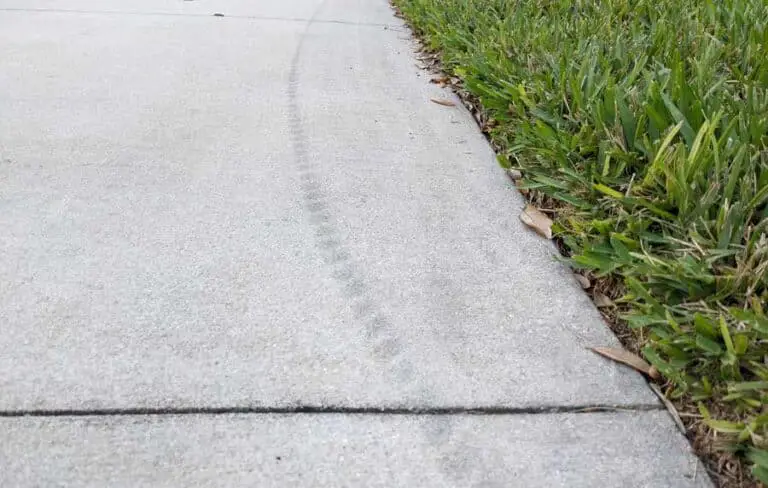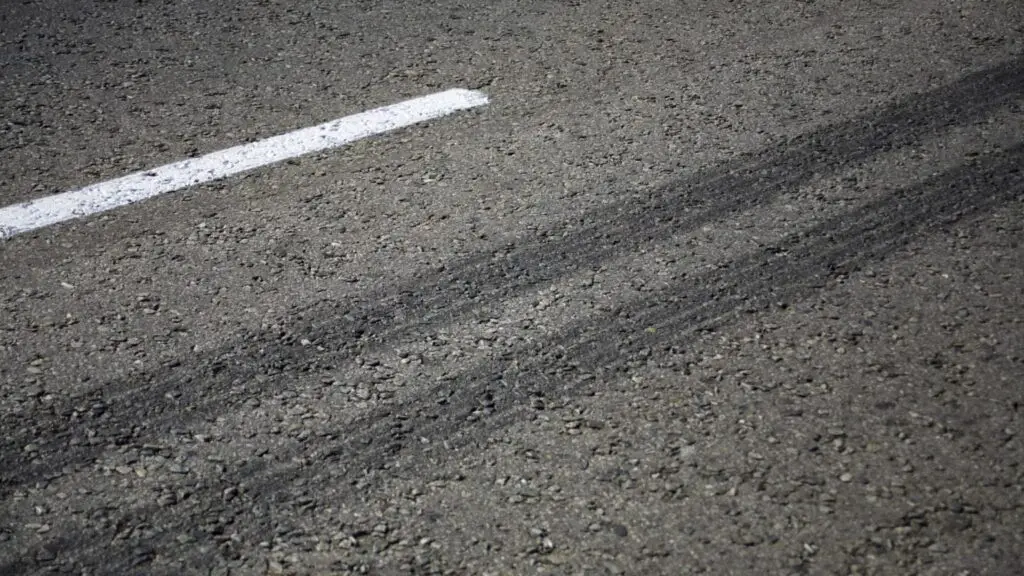Do tire marks on driveway go away? Tire marks on driveways generally do not disappear on their own without intervention. While some marks may fade over time due to weather exposure, most require cleaning methods like pressure washing or chemical cleaners to fully remove them.
It might be uncomfortable to see tire marks on your driveway, especially if they are there for a long time. The spots can be unsightly and even give the impression that your driveway has been neglected, whether they are caused by a sharp turn, abrupt braking, or the heat from the tires.
One common question homeowners have is: Do tire marks on the driveway go away on their own? The answer is, there are several factors to consider, including the type of driveway surface, the age of the marks, and the weather.
In this article, we will explore the causes of tire marks, whether they go away naturally, and most importantly, how you can effectively remove them to restore the beauty of your driveway.

Contents
What Are Tire Marks on Driveways?
Tire marks, often called “skid marks” or “tire stains,” are the dark streaks or patches left on the surface of a driveway after a vehicle drives over it. These marks are usually caused by the transfer of rubber compounds from the tires onto the driveway, especially under certain driving conditions. Tires can leave these marks more easily when they are hot or when heavy braking or accelerating occurs.
What Causes Tire Marks?
Several factors contribute to the formation of tire marks on your driveway:
- Hot Tires: When you drive, the friction between the tires and the road generates heat. This heat softens the rubber in the tires, making it more likely to leave a mark on the surface of the driveway.
- Heavy Braking or Acceleration: Sudden braking or rapid acceleration can cause the tires to spin or skid, leaving marks on the driveway surface.
- Tire Composition: The rubber compounds used in tires, including plasticizers and oils, can transfer to the surface of your driveway, particularly when the tires are hot and soft.
- Driveway Material: Different driveway materials interact differently with tire marks. Concrete and asphalt are more prone to tire marks than gravel or brick driveways because they have smoother, less porous surfaces.
Do Tire Marks Go Away on Their Own?
The short answer is: it depends. Some tire marks will fade over time, especially if they are relatively fresh and if the driveway is exposed to elements like rain, sunlight, and temperature changes. However, most tire marks will not disappear entirely without intervention. Here’s why:
- Type of Driveway Surface: Tire marks on concrete and asphalt tend to be more noticeable and can be harder to remove because these materials are non-porous, meaning the rubber compounds sit on the surface rather than soaking in. On the other hand, tire marks on porous surfaces like gravel or brick are often less visible or easier to clean.
- Age of the Tire Marks: Fresh tire marks may disappear naturally over time as the rubber breaks down or is worn away by normal weather conditions. Older tire marks, especially those that have been left for weeks or months, may require more effort to remove and may not fade away completely.
- Environmental Factors: Rain and moisture can help break down the rubber and may cause some marks to fade. Similarly, sunlight can dry out the rubber, causing it to break up and disappear over time, but this process is usually slow.
While some tire marks may fade naturally, most will require cleaning or treatment to fully remove them.
How to Remove Tire Marks from Driveways
If you’re tired of looking at tire marks on your driveway, there are several effective methods you can use to clean them. Below are some common techniques that will help you restore the appearance of your driveway.
1. Pressure Washing
One of the most effective methods for removing tire marks is using a pressure washer. A pressure washer uses high-pressure water to blast away dirt, grime, and rubber residue. This method works well for both concrete and asphalt driveways.
- How to Use: Attach the appropriate nozzle to your pressure washer, and direct the spray at the tire marks. Work in a sweeping motion and keep the nozzle a few inches away from the surface to avoid damaging the driveway.
- Effectiveness: Pressure washing is highly effective for newer marks and can remove most tire marks with minimal effort.
- Caution: If you have a porous driveway or if the pressure is too high, be cautious to avoid causing damage to the surface.
2. Chemical Cleaners
If pressure washing doesn’t totally remove the tire imprints, you might try using a chemical cleaning. There are various industrial cleaners intended exclusively for eliminating tire marks from driveways. These cleaners break down rubber compounds, making it easier to brush away stains.
- How to Use: Apply the cleaner directly to the tire marks and let it sit for a few minutes to break down the rubber. Afterward, scrub the area with a stiff-bristled brush and rinse it off with water.
- Effectiveness: Chemical cleaners are effective on older or stubborn marks and can remove both fresh and long-standing stains.
- Caution: Always read the instructions on the product to avoid damaging the driveway surface. Some cleaners may be harsh and require dilution before use.
3. Homemade Solutions
If you prefer a more eco-friendly solution, you can make your own cleaning mixture using common household items like baking soda or vinegar. These ingredients can be just as effective as commercial cleaners when it comes to removing lighter tire marks.
- How to Make the Solution: Mix 1 cup (0.24 liters) of baking soda with water to form a thick paste. Apply the paste to the tire marks and let it sit for 10–15 minutes. Use a scrub brush to work the paste into the marks, and rinse with water.
- Effectiveness: This method is ideal for minor tire marks and is less harsh on the environment.
- Caution: Baking soda paste may not be as effective on older, more ingrained tire marks.
4. Scraping with a Putty Knife
For fresh tire marks, a plastic putty knife or scraper can help remove the rubber from the driveway without damaging the surface. This method is best for marks that haven’t fully bonded to the driveway yet.
- How to Use: Gently scrape the tire marks with the putty knife, being careful not to scratch the driveway. Work from the edges of the tire marks inward to avoid spreading the rubber.
- Effectiveness: Scraping is effective for removing fresh, light tire marks.
- Caution: This method works best for fresh marks and may not be as effective for older or heavily ingrained stains.
5. Seal coating Your Driveway
If you want to prevent future tire marks, consider seal coating your driveway. This protective layer helps prevent rubber, oil, and other substances from staining the surface and makes it easier to clean. Seal coating also extends the life of your driveway and improves its overall appearance.
- How to Use: Apply a sealant specifically designed for your driveway material. Most sealants can be applied using a roller or sprayer.
- Effectiveness: Seal coating is preventative rather than a removal method, but it can help protect your driveway from future marks and stains.

Related Article
How To Clean Brake Fluid Off Driveway
How to Get Tire Shine off Driveway
Frequently Asked Questions
Here are some FAQs about tire marks on driveway –
1. How long does it take for tire marks to fade?
Tire marks can fade naturally over time, especially if exposed to rain and sunlight. However, the process can take several weeks or even months, depending on the severity and age of the marks.
2. Are tire marks harder to remove from asphalt or concrete?
Tire marks tend to be more noticeable and harder to remove from concrete due to its smooth and non-porous surface. Asphalt is slightly more porous, which can make it easier to clean.
3. Can I remove tire marks with just water?
Water alone is usually not enough to remove tire marks, especially older or stubborn stains. A combination of water, a scrub brush, and cleaning agents is typically necessary for effective removal.
4. Is there a way to prevent tire marks on my driveway?
Regular cleaning and applying a sealant to your driveway can help prevent tire marks from forming. Additionally, avoiding rapid acceleration or heavy braking can reduce the likelihood of leaving tire marks.
5. Can I use a pressure washer to clean tire marks from any type of driveway?
Pressure washing works well on concrete and asphalt driveways, but be cautious when using it on porous surfaces like gravel or pavers, as the high pressure can cause damage.
Conclusion
Tire marks on driveways may seem like a permanent issue, but they are typically manageable with the right techniques. While some marks may fade naturally over time, using pressure washing, chemical cleaners, or homemade solutions can effectively remove them.
By following proper maintenance practices and taking steps to prevent future marks, you can keep your driveway looking clean and well-maintained. Whether you have a concrete, asphalt, or gravel driveway, the right approach will ensure that tire marks don’t become a long-term problem.